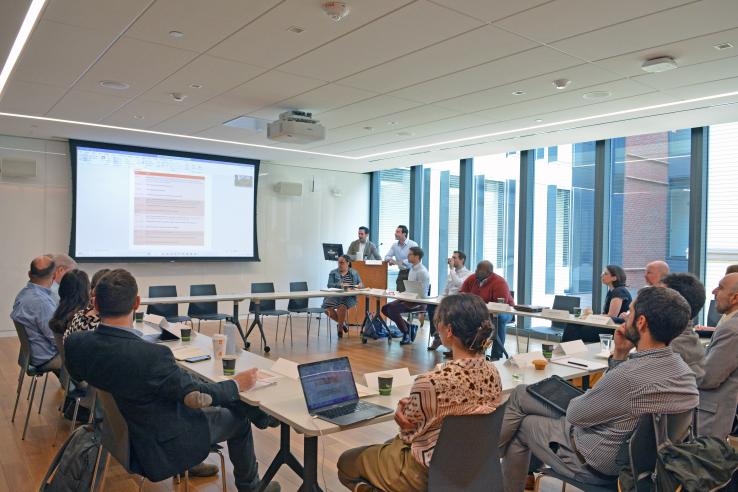
At Yale, scholars and policymakers unite to improve state Medicaid program

This article originally appeared on Yale News.
On a recent morning, administrators of Connecticut’s Medicaid program visited Yale’s Tobin Center for Economic Policy for a brainstorming session.
In a conversation with social scientists from across Yale’s campus and beyond, they examined how the latest evidence-based research might strengthen the state’s public health system — and improve health outcomes for the approximately 1 million Connecticut residents who rely on it.
Specifically, they explored the potential to enhance and improve the Medicaid program through randomized-controlled trials (RCTs), which are prospective studies that measure the effectiveness of policy interventions.
The meeting marked the beginning of a unique partnership between the State of Connecticut, the Tobin Center, and the Abdul Latif Jameel Poverty Action Lab (J-PAL) at MIT that aims to harness evidence-based social science research to improve the public health system.
“Part of our mission involves working with folks from other universities and state agencies to try to do some good,” Zack Cooper, the Tobin Center’s associate faculty director, said at the start of the brainstorming session. “The plan today is to bring a bunch of researchers together with J-PAL North America, which is phenomenal at implementing RCTs, and state policymakers to let everyone kick ideas around and move the conversation from ‘it would be interesting if…’ to getting some projects launched.”
Collaboration of this sort lies at the heart of the Tobin Center’s mission, said Cooper, an associate professor of health policy at Yale School of Public Health and of economics in Yale’s Faculty of Arts and Sciences. That mission, he says, is to facilitate rigorous, policy-relevant social-science research that improves people’s lives and to engage with policymakers in a manner that reduces the time between studies and real-world impact.
Earlier this spring, during a visit to the Tobin Center, Connecticut Governor Ned Lamont agreed to a series of policy collaborations between Yale and the state. Among other commitments, the Tobin Center has embedded a data scientist into the Medicaid program to help inform research and identify areas of need. It also has aligned the Governor’s Fellowship Program — a Yale-supported initiative that links a diverse set of talented, early-career professionals with senior state leaders to solve pressing policy issues — with the state’s Medicaid priorities.
The use of randomized controlled trials, which researchers use to rigorously evaluate the impact of policy interventions, is a key component of the new partnership. Randomly sorting a population into two groups — one that receives an intervention and one that does not — ensures that at the beginning of the study the groups will be the same on average. This way, any difference in outcomes between the groups at the study’s completion can be attributed to the intervention rather than other causes.
RCTs are the best method available for evaluating whether policy interventions achieve their intended goals, Cooper said.
Gui Woolston, a Stanford-trained economist who directs the Connecticut Medicaid program, has expressed optimism in working with scholars from Yale and elsewhere to implement RCTs and improve public policy.
“This is an incredible opportunity for partnership to drive evidence-based policy making,” Cooper said. “It is exceedingly rare that the director of a state Medicaid program has a Ph.D. in economics and is interested in randomized trials.”
The brainstorming session included eight Yale faculty members representing the School of Public Health, the School of Management, and the Department of Economics, as well as researchers from Boston University, Harvard Medical School, and the University of Wisconsin-Madison. Also participating were representatives from J-PAL North America, an organization based at the Massachusetts Institute of Technology with vast experience implementing randomized evaluations of policy interventions throughout the world.
At the start of the discussion, Woolston set three criteria for potential policy interventions: Any proposed actions, he said, must be important, budget neutral, and feasible.
“Within those three brackets, I think there’s a lot we can accomplish,” Woolston said.
In Connecticut, Medicaid and the Children’s Health Insurance Program (CHIP) are folded together into HUSKY Health, the state’s public health coverage program. With an annual budget of $9.2 billion, HUSKY Health provides coverage to more than 1 in 4, or 30%, of Connecticut’s 3.5 million residents, including 1 in 6 adults, 1 in 3 children, 4 in 10 births, and 2 in 3 nursing home residents, according to state data.
One of the non-traditional health care programs the group discussed was a proposed intervention that would help people eat healthier. Medicaid programs in other states have implemented similar initiatives that provide members nutrition counseling and education, meals tailored to their medical needs, and “produce prescriptions” to access fresh fruits and vegetables.
Yale has built a dataset linking information on state Medicaid recipients and residents enrolled in the federal Supplemental Nutrition Assistance Program (SNAP), said Chima Ndumele, associate professor of public health (health policy) at the Yale School of Public Health.
“We already have substantial data on the overlap between those two programs,” Ndumele said. “The infrastructure is in place to support RCTs in this area, which is ripe for study and could be a catalyst for interventions that improve the nutrition and long-term health outcomes for individuals and families in our state.”
The participants also contemplated interventions to help people incarcerated in the state’s prisons enroll in Medicaid within 90 days of their release, which could allow them to have a primary care provider, behavioral health clinician, and prescription drug coverage in place once they are freed.
The Medicaid administrators were eager to evaluate how well their public outreach campaigns influence people’s behavior. They expressed a need to better understand what types of messages and delivery methods are most effective at motivating people to schedule medical appointments and commit to preventive care, including dental visits and flu shots. Helping people access dental care is particularly difficult, they said, noting that 70% of adult Medicaid recipients did not visit a dentist in 2022.
The researchers suggested potential outreach interventions aimed at helping members with appointment scheduling and reminders, and transportation.
During a conversation on long-term care, the experts discussed interventions designed to provide Medicaid recipients more autonomy over the type of long-term services and support they receive. A key goal of such initiatives, administrators said, is to help those who want to live at home (as opposed to moving to a nursing home) do so, which would reduce costs. The state Medicaid program pays for about 70% of nursing-home care residents, which totaled $1.12 billion in spending in 2020.
Researchers suggested interventions for helping people plan their long-term care before they require it so that choices are made before their health circumstances become urgent.
“Hopefully, you all have a better sense of our priorities and the limits of resources,” Woolston said at the session’s end. “I’m hoping in the coming days we can move forward with a subset of these ideas.”
Participants agreed to follow up with each other on research ideas.
“This isn’t the last of these conversations,” Cooper said. “Hopefully, this has created some connective tissue.”
Media Contact
Bess Connolly : [email protected]
Related Content

Reflecting on the benefits of evaluating a health care delivery program: A recap from the HCDI @ 8 Convening

Beyond causality: Additional benefits of RCTs for improving health care delivery

